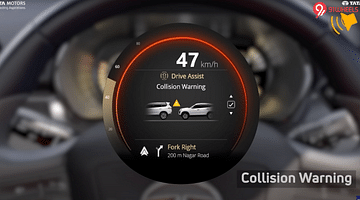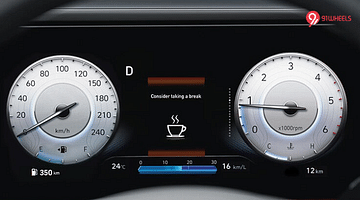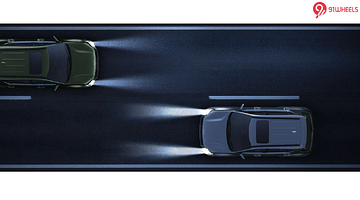
KEY HIGHLIGHTS
- The term "ADAS" is frequently used in vehicle marketing, but its role often remains unclear.
- Now, with terms like "Level 1" and "Level 2" adding complexity, the confusion has increased even more.
- Let's understand ADAS and its functions in the simplest way possible.
I'm sure you're tired of hearing phrases like "this car is equipped with ADAS" or "ADAS Level 2 available in the top model." But have you ever wondered how ADAS truly impacts our daily driving habits? Plus, what is the difference between Level 1 and Level 2? Here, I'm going to clear up any ambiguity around this safety system and provide you with detailed information to help make your car buying decision firmer. Before that, make sure to join our join our 91Wheels WhatsApp Group to stay updated on the latest automotive news and industry insights.
Also Read: BEV or PHEV or MHEV? Let's Understand These Electric Vehicles
The term ADAS stands for Advanced Driver Assistance Systems. It utilises sensors, cameras, and radar to keep the car safe and secure from its surroundings, to help avoid accidents. The concept of ADAS is based on the principle that it can detect things a human driver might miss.
For instance, while making a U-turn, a driver might need to reverse for a perfect right turn. During this maneuver, the driver might not see another vehicle approaching to take the U-turn. In this scenario, ADAS helps by providing alerts and voice commands, or in the case of Level 2 ADAS, it can even apply the brakes before the driver reacts. This specific feature within ADAS is called "Rear Cross Traffic Collision Warning." This is just one example, down below we'll learn about other features of the ADAS.

Let's start with Passive ADAS
The passive way of ADAS is to provide a view of the situation and alert the driver to take action. However, there is no direct connection between the sensors and the car controls, so all actions must be performed by the driver.
ABS - Anti lock breaking system doesn't lock the wheels, when suddenly brakes are applied to make sure the vehicle doesn't skid away. Every vehicle coming now is equipped with ABS.
ESC - Electronic Stability Control (ESC) is essential in unexpected situations when the driver quickly changes the vehicle's direction at high speeds. This sudden maneuver can lead to understeer or oversteer, potentially resulting in an accident. ESC helps prevent this by applying brakes to the specific wheel that has lost traction.
TCS - The Traction Control System (TCS) regulates the ABS and ESC to ensure they provide adequate traction to each wheel. If the system detects a loss of traction, it immediately applies the brakes or, in some situations, shuts off engine.
Back Up Camera - This camera activates when the reverse gear is engaged, providing a view of the rear end along with guiding lines to help the driver see where the car will move.
Sensors - Located on the front, rear bumpers and fenders, this system alerts the driver when the car is in close proximity to an object. As the proximity decreases, the alert sound becomes more urgent, prompting the driver to take immediate action.
Hill hold assist - This feature holds the car for three seconds when it senses that the car is on a steep incline to prevent it from rolling back. This is particularly useful in manual cars, where during steep climbs, the driver must actively manage the clutch, handbrake, and accelerator. In challenging situations like these, hill hold assist proves invaluable.
Let's talk about Active ADAS

Adaptive Cruise Control - The car's speed adjusts according to the vehicle ahead. If you've set it at 80 km/h and the front vehicle varies its speed, your car slows down to avoid collisions. Once the vehicle ahead moves away, adaptive cruise control will resume your set speed automatically.
Automatic Emergency Braking - As the name suggests, this system automatically applies brakes, when it sense an obstacle. This system is also called, Front or Rear collision assistant.
Lane Assist - This feature prevents lane changes unless you activate the turn signal. It can be enabled or disabled through vehicle settings, as it's particularly useful during long journeys.
Autonomous Driving - When the driver isn't actively controlling the car, the intelligent computer, aided by cameras and radar, takes charge, resulting in autonomous driving. However, the driver must still remain attentive as the MID prompts to focus ahead. In autonomous mode, the vehicle manages gear changes, steering, braking, and lane changes.
Driver Drowsiness Alert - Contrary to the external cameras, there's an additional camera inside the car that monitors the driver. This technology's responsibility is to ensure the driver remains attentive and alert, detecting signs of fatigue.
If it senses fatigue, the system notifies the driver via a message on the MID, advising them to take a break with a message like "Consider taking a break."

ADAS Level 1
Level 1 ADAS means the car can only handle one action at a time. For instance, if you engage adaptive cruise control, it will only manage that task. If you activate lane-keeping assist, it will focus solely on that. In Level 1 ADAS, the driver must remain fully attentive and ready to take action at any moment. In this system, both the driver and the intelligent computer share control of the vehicle. Popular cars in India with Level 1 ADAS include the Honda City, Kia Sonet, and MG Gloster.
ADAS Level 2
Level 2 ADAS means the car's system can manage two functions simultaneously, such as steering, acceleration, and braking. This allows for short periods of autonomous driving, during which the driver can briefly take their hands off the wheel. However, automakers advise against fully relying on this system and recommend remaining attentive. Both Tesla's Autopilot and Mercedes' Drive Pilot emphasize this. In some instances, ADAS has proven effective in smartly avoiding accidents.
Some popular indian cars which offer ADAS Level 2 are, Mahindra XUV 700, Hyundai Creta, Kia Seltos, and Tata Safari.

Below is a list of some of the common safety features found in ADAS:
Front Collision Avoidance Assist
Lane Keep Assist
Lane Departure Warning
Front Collision Avoidance Assist
Lane Keep Assist
Door open alert
Safe exit warning
Lane Departure Warning
High Beam Assist
Also Read: Cars With 360-Degree Camera Under Rs 20 Lakh In India
Verdict
The future of mobility will be governed by ADAS, as more automakers are incorporating this intelligent safety system into all their models. The primary aim of ADAS is to prevent road accidents and promote sensible driving. However, it is essential for us, as drivers, to practice responsible driving and not rely solely on machines.















































































